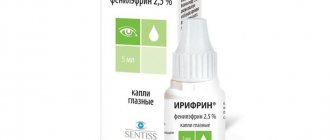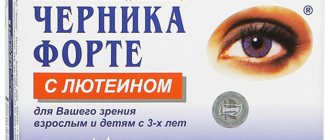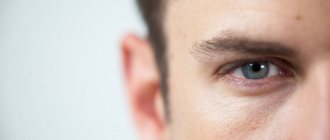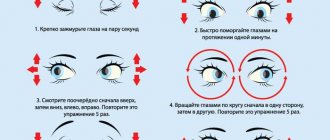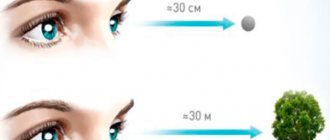There are well-known signs of the development of symptoms of dry eye syndrome (DES) and associated discomfort (feeling of a foreign body, sand in the eyes, lacrimation) in patients undergoing contact vision correction, including with the help of soft contact lenses (SCL) [1-10 ]. There is also a fairly wide range of eye medications for relieving these phenomena, preventing and treating possible microtraumas and lesions of the cornea [9-11]. The problem is very relevant, since not all such drugs on the global pharmaceutical market are widely available to Russian patients and are suitable for long-term use.
The use of a 4% solution of the drug Taufon has become widely known in therapeutic ophthalmology [1, 3, 4, 11, 12], especially for pathologies of the ocular surface (cornea and conjunctiva), as well as for a number of diseases of the organ of vision of a dystrophic nature, which have very pronounced stimulating and regenerative properties and the ability to activate the flow of energy, restoration and reparation processes in the tissues of the eye. An important property of the 4% Taufon solution was its effect on the production of water-soluble mucins and glycocalyx mucins by conjunctival goblet cells, which has a stabilizing effect on the tear film. All this was the prerequisite for our clinical study of a 4% solution of the drug Taufon for contact vision correction using silicone hydrogel SCLs in patients with stationary mild, moderate and high myopia.
The purpose of the study is to study the possibility of clinical use and effectiveness of Taufon eye drops for contact vision correction using silicone hydrogel SCLs in patients with stationary forms of mild, moderate and high myopia.
The effectiveness of drops for myopia
This disease is primarily associated with deviation of the shape of the eyeball from the norm. Because of this, light rays are refracted incorrectly and a person sees objects blurry. With a high degree of myopia, the visibility of nearby objects deteriorates.
Treatment of myopia involves correcting visual impairment using contact lenses or glasses. Eye drops are used to prevent abnormal development of the eye and relieve fatigue. They bring results when combined with proper nutrition and therapeutic exercises. Optical vision correction is necessary in this case.
Drops for fatigue and irritation are necessary for those myopic patients who work at the computer for a long time. Medicines with added vitamins normalize metabolism in the tissues of the eye and improve blood circulation. Solutions for myopia also restore the functionality of the retina and preserve vision in myopia.
conclusions
1. A comparative study of the effectiveness of eye drops for the prevention of dry eye symptoms in patients with stationary myopia who used silicone hydrogel SCLs Air Optix Night & Day (“Ciba Vision”) and Pure Vision 2HD (“Bausch & Lomb”), conducted in three statistical studies comparable clinical groups, revealed significant advantages of using a 4% solution of the drug Taufon in patients of the main group in comparison with the results obtained both in patients of the 2nd group who received natural tears, and in patients in the control group, which is confirmed by an increase in the clinically significant effect.
2. It seems promising to use a 4% solution of the drug Taufon for the prevention and treatment of possible morphofunctional disorders in the cornea and conjunctiva associated with the development of symptomatic forms of dry eye with long-term use of SCL in patients with stationary myopia, which determines the need for further long-term follow-up with a comprehensive study and analysis of the obtained data.
Classification of drops
Drops can be prescribed to normalize vision for any degree of refractive error. They contain the optimal amount of microelements, vitamins and other chemical compounds that strengthen the structures of the eye.
Drugs for the treatment of myopia vary depending on their principle of action:
- The drugs are “artificial tears.” They are prescribed for dry eyes, which occurs, in particular, due to prolonged visual stress.
- Drugs that reduce the intensity of fluid production and improve its outflow.
- Antibacterial drugs to eliminate the activity of microorganisms.
- Anti-inflammatory drops.
- Vitamin preparations that saturate the eye tissues with nutrients and oxygen.
- Vasoconstrictor drops. They effectively narrow the lumen of the blood vessels of the eye.
- Antihistamines used in the development of allergic reactions.
- Antiviral drops are used to fight viruses. They contain an analogue of interferon, which prevents the development of the pathogen and helps the body cope with pathology.
Results and discussion
The initial indicators of VRSP, OSDI and PRS in all groups did not differ significantly (see table)
.
During control examinations carried out after 7, 30, 60, 180 days of wearing SCLs, it was found that in the 1st group of patients who received instillation eye drops of a 4% solution of the drug Taufon, pathological pathologies were recorded significantly less often than in patients of other groups. changes in the cornea, bulbar and tarsal part of the conjunctiva ( p
<0,05).
All patients of group 1 who received Taufon noted an improvement in the condition of the eyes after instillation, the disappearance of redness and eye fatigue, lacrimation, burning and stinging in the eyes, and increased sensitivity of the eyes to light. Subjective improvement in vision after instillation of drops was noted by all patients. In all eyes, biomicroscopy with a fluorescein test revealed the absence of deepithelialization phenomena, regression of limbal neovascularization, which did not exceed 0.5 mm, and flattening of the tarsal conjunctival papillae with a decrease in their number. At the end of the study, an increase in tear film stability time (TST) was reliably established, and signs of reverse development of dry eye symptoms were identified, which indicated the effectiveness of the drug used.
In group 2, at the end of the study, weakly positive dynamics were recorded in the regression of dry eye symptoms, which was manifested by a decrease in the number of pinpoint areas of corneal de-epithelialization, when stained with a 0.2% fluorescein solution from 5 to 10 loci. The area of perilimbal hyperemia at the beginning and end of the study remained at the same level. Some patients in the same group showed an insignificant decrease in tarsal conjunctival hyperplasia, which did not significantly affect the values of VRSP, OSDI and PRS at the end of the observation period (see table)
.
In the 3rd group of patients with stationary myopia, a high frequency of subjective complaints of patients about a feeling of discomfort and a feeling of dry eyes was noted. During biomicroscopy after staining with a solution of 0.2% fluorescein, more than 20 point defects of the corneal epithelium, localized in different parts of the cornea, were recorded. A slight expansion of the zone of perilimbal hyperemia of the conjunctiva was also recorded, which increased to 1.5 mm from the scleral part of the limbus. The obtained values of VRSP, OSDI and PrSh at the beginning and end of the observation period are reflected in the table and confirm the identified changes.
The values of corneotopographic and pachymetric parameters obtained at the beginning and end of the study (520±0.32 µm) were relatively constant and stable throughout the study in patients of all three groups. There were also no changes in endothelial cell density (ECD), which corresponded to the age norms of patients, averaging 2630±748 cells per 1 mm2. All these indicators remained unchanged throughout the study.
List of effective drops for myopia
For myopia, these are the most effective drugs used.
Irifrin
These are one of the frequently prescribed drops for the treatment of myopia. Available without a prescription. You should pay attention to the concentration of the active component phenylephrine, which changes the duration of exposure. The shelf life of this product is no more than a month after opening. It is not recommended to use Irifrin for diabetes mellitus, liver pathologies, or increased heart rate.
Irifrin has the following effect:
- constricts the eye vessels;
- eliminates dry mucous membranes;
- prevents the development of spasm of accommodation.
Taufon
These drops contain the amino acid taurine. It has a regenerating effect. It is recommended to use drops from the first day when myopia is diagnosed. Available without a prescription. Taufon has the following effect:
- improves vision;
- relieves tension and fatigue;
- activates metabolic processes in eye tissues;
- improves cell nutrition.
Vita-iodurol
Vita-iodurol saturates the lens of the eye with useful microelements, vitamins, and amino acids. Helps speed up metabolism in the eyes. Drops are contraindicated for:
- childhood;
- pregnancy;
- lactation.
Do not wear soft lenses during treatment.
Quinax
This is a drug enriched with vitamin C. Drops increase visual acuity, improve the outflow of eye fluid, and stabilize the functioning of the lens.
Quinax is not recommended during breastfeeding or pregnancy.
Ujala
These drops are often recommended for the prevention of myopia. Ujala can be purchased in specialized Ayurvedic stores. They have the following effect:
- cleanse the circulatory system of the eye;
- relieve tension and fatigue;
- eliminate the inflammatory process;
- saturate the eye tissue with nutrients and microelements.
Emoxipin
This product is available by prescription. Strengthens the vascular system of the eye. Protects the cornea from adverse factors. Emoxipine is contraindicated for the treatment of persons under 18 years of age, during pregnancy and lactation.
Okovit
These are vitamin drops to reduce the manifestations of myopia. Under its influence:
- color perception improves;
- eye structures are restored;
- the condition of the choroid improves.
You can find out more about the drug here
Oftan Katahrom
The drug contains vitamins necessary for the normal functioning of the eye. Katachrom relieves visual tension, improves the condition of the organ of vision, and slows down the progression of myopia.
Drops are prohibited for children under 18 years of age.
Balarpan
These drops contain glycosaminoglycans - natural components that are part of the connective tissue of the cornea. Prescribed for eye injuries to accelerate the regeneration of its tissues. They are also used to relieve eye fatigue, dryness and pain. Improves tolerance of contact lenses.
Balarpan can be used in complex therapy of infectious diseases.
Material and methods
90 patients (180 eyes) aged from 28 to 45 years suffering from a stationary form of myopia were observed. All patients were divided into 3 groups of 30 patients (60 eyes) each. All groups were homogeneous in quantitative and qualitative composition, statistically comparable in gender, age and degree of myopia, which was stationary. The average period of wearing SCL in all patients was 5.0±3.3 years.
In all patients, contact vision correction was performed using silicone hydrogel SCLs Air Optix Night & Day (Ciba Vision) and Pure Vision 2HD (Bausch & Lomb).
These contact lens samples, as shown by our previous studies [11], are an effective means of accelerating the repair time of corneal graft tissue during penetrating keratoplasty. The choice of silicone hydrogel SCLs for research is explained by the fact that they have high rates of oxygen transmission and a biocompatible plasma surface that is resistant to protein deposits [7, 10].
In addition, these SCLs are certified in Russia and are successfully used for the correction of ametropia [1, 3, 4, 11]. The distribution of patients depending on the type of SCLs we used in each group was almost the same.
Exclusion criteria from the study included the following (clinically significant) factors. Patients with general somatic diseases, diabetes mellitus, endocrine and autosomal diseases, any manifestations of allergies, those who used ophthalmic medications on the eve of the study, patients with any pathology of the ocular adnexa, with diseases and injuries of the cornea, or previous surgical and laser operations on the cornea were excluded.
All patients underwent a standard ophthalmological examination: visometry, biomicroscopy, pneumotonometry, aberrometry, refractometry, endothelioscopy, corneotopography, pachymetry.
The study used an optical coherence tomograph of the anterior segment of the eye OCT VISANTE (“Carl Zeiss”) using the Pachymetry Map and High programs. Res. Corneal, biomicroscopy of the anterior segment of the eye was performed using a slit lamp, endothelial microscopy using a device.
The initial data of a high-resolution pachymetric map of the cornea with determination of the central corneal thickness (CCT), as well as endothelioscopy data with determination of the density of endothelial cells (EC) in 1 mm2 of the cornea at the beginning and at the end of the study were analyzed.
In addition to the standard ophthalmological examination, all patients underwent a comprehensive examination of the lacrimal system [3, 5, 12, 13], including the Schirmer test (Sch) using Vidisik test strips (Bausch & Lomb), and the tear film breakup time test (TBR). The Ocular Surface Disease Index (OSDI) questionnaire was used to assess symptoms of dry eye syndrome.
The criterion for including patients in the study groups was to identify, according to the classification of “Risk Factors for the Development of Dry Eye Syndrome When Wearing Contact Lenses,” risk factors with mild manifestations of dry eye symptoms when wearing SCL for at least 5 years [1].
The criteria for the effectiveness of the drugs used in the study were the stability of PRS indicators of more than 10 mm, the HRSP test of at least 10 s, the OSDI index of no more than 15 points, the absence of negative or positive dynamics when assessing subjective and objective symptoms of dry eye syndrome. The condition of the epithelium of the cornea and conjunctiva was examined after preliminary staining with a 0.2% fluorescein solution.
When biomicroscopy of the cornea and perilimbal zone of the conjunctiva in patients of all groups, almost identical changes in the corneal epithelium were recorded, which, when stained with a 0.2% fluorescein solution, amounted to no more than 10-15 point defects of the epithelium, especially in the lower parts of the cornea. Perilimbal changes in the conjunctiva were in the form of mild hyperemia and neovascularization of limbal vessels within the range of 0.75-1.0 mm. In the tarsal part of the eyelid conjunctiva in patients of all three groups, mild and moderately expressed papillary hypertrophy was noted.
Group 1 included 30 patients (60 eyes) with stationary myopia, who during contact correction used eye drops of a 4% solution of the drug Taufon twice a day before installing and after removing the contact lens.
Group 2 included 30 patients (60 eyes) with stationary myopia, who used natural tears for contact vision correction using SCLs (), also 2 times a day before installing and after removing SCLs.
The 3rd control group (without drugs) included 30 patients (60 eyes), experienced contact lens users with stationary myopia, who did not use any eye drops, and when symptoms of dry eye occurred, limited themselves to shortening the period of wearing SCLs or switching to spectacle correction within 1-2 days.
Monitoring of the condition of the cornea was carried out in the near future (usually 20-30 minutes) after removal of the SCL.
Statistical processing of the data was carried out using nonparametric statistics methods. The programs used were Excel (Microsoft Office-2007) and Statistica-6.0 (Statsoft).
Drops for myopia for children
A significant number of drops for the treatment of myopia are prohibited for use by children. Still, there are drugs that can be instilled into children's eyes. Some of them are introduced only under medical supervision.
We recommend reading: How to put drops in a child’s eyes
The most common means used for children are:
- Irifrin is an effective remedy for preventing the development of false myopia. It is allowed to be used from the age of 12 under the supervision of an ophthalmologist.
- Taufon is a drug that improves the nutrition of eye tissue. It can be given to small children under the supervision of an ophthalmologist.
- Emoxipine can only be used with the permission of a pediatrician.
- Visioned is prescribed to children from 3 years of age. These are drops with plant extracts containing vitamins that are beneficial for the eyes. Strengthens the retina and restores vision.
Causes of myopia
Myopia is a refractive error in the eye in which light rays are focused in front of the retina rather than on the retina. According to statistics, 25% of the population of our planet faces this disease.
There are two main reasons for the development of the disease:
- An abnormality of the eyeball
(when the apple is elongated) is the most common cause. - The optical power of the eye's optical system is too high.
In this case, the lens or cornea has an irregular shape, for example, the cornea of the eye may be too round, curved, or convex.
The following factors can contribute to the occurrence of myopia:
- Heredity
- a child inherits a physiological predisposition to myopia from myopic parents. - Weak accommodation
is the insufficient ability of the eye to rearrange the optical system near/far to clearly distinguish objects at different distances. - Weakening the strength properties of the sclera.
- injury
, eye injury. - Overwork, stress, decreased immunity, some diseases.
- Sudden physical activity.
- Intense work associated with constant visual stress at close range.
Pregnant women may experience temporary
myopia. This is due to hormonal disorders in the female body during this period. For this type of myopia, treatment may involve taking medications that can improve visual acuity during pregnancy. After childbirth, as a rule, vision is restored.
Vitamin preparations
Vitamins for the eyes should come not only from food, but also in the form of vitamin supplements. They have the following effects:
- relieve pain;
- remove redness from the eyes;
- nourish cells and tissues;
- fight visual fatigue.
To prevent visual impairment due to myopia, the following drops and tablets are used.
| Drug name | Main characteristics of the medicine |
| Quinax | These are drops with a pronounced antioxidant effect. The tight junctions present in the lens are dissolved. It contains vitamins A and C. It is prescribed to prevent the progression of not only myopia, but also cataracts and glaucoma. |
| Strix Forte | The tablets are recommended for people who work with gadgets for a long time. Contains blueberry extract vitamin A, trace elements – zinc and selenium. Useful for mild myopia. |
| Superoptik | Capsules containing omega-3 fatty acids, vitamins C, B3, B6, B2, B1, A, E, cyanocobalamin and folic acid. Recommended for intense visual work, exposure to intense sunlight, and driving at night. |
| Askorutin | Contains vitamins C and P. Drops and tablets reduce the permeability of the capillaries of the eye and have anti-inflammatory activity. |
| Complivit Oftalmo | A combined preparation containing vitamins, minerals and antioxidants of plant origin. Used for visual fatigue. |
| Tropicamide | It is actively used to prevent the progression of myopia, eye strain and fatigue. |
